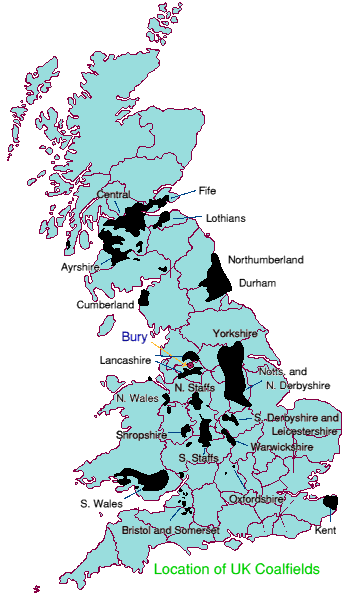![]()
Where is Coal Found?Coal measures occur in many countries around the world. China is believed to have the greatest reserves, around 40% of the total, and Russia has large quantities of both coal and lignite, though much of it is in inaccessible regions of Siberia. North America also has significant deposits.  Black areas are the main coal deposits in Britain. In the early 1980s British coal production was around 100 million tonnes per year, with recoverable reserves of coal estimated at 45 billion tonnes, out of a total reserve (mostly inaccessible) of maybe 160 billion tonnes. The Nottinghamshire and Derbyshire coal field in fact extends eastwards under the North Sea and some natural gas, from the southern part of the North Sea, originates from these underlying coal measures. The types of animals which lived in the forests which became coal swamps included crabs and shrimps, and particular types of mussels in lakes within the forests. If test boreholes yield mussel fossils of the correct species this can be be used to predict the presence of coal deposits in the area. This technique was used in Britain in the mid 20th century to find the new coal supplies needed for expanding industry. | |||||
Types of Coal(Most of this section is derived from the 'International Correspondence Schools' manual on 'Fuels, Steam and Steam Engines', 1907.)
| |||||
| The approximate compositions of peat, lignite, bituminous coal and anthracite are given in the following table: | |||||
| Fuel | Composition - % by Weight | Approx. Calorific Value (kJg-1) | |||
|---|---|---|---|---|---|
| Carbon | Hydrogen | Nitrogen | Oxygen | ||
| Peat | 55.44 | 6.28 | 1.72 | 36.56 | 10 |
| Lignite | 72.95 | 5.24 | 1.31 | 20.50 | 20 |
| Bituminous Coal | 84.24 | 5.55 | 1.52 | 8.69 | 30 |
| Anthracite | 93.50 | 2.81 | 0.97 | 2.72 | 34 |
Notice how in changing from peat to anthracite the oxygen content reduces greatly because of loss of water, and the calorific value (how much energy is obtained by burning it) goes up. |